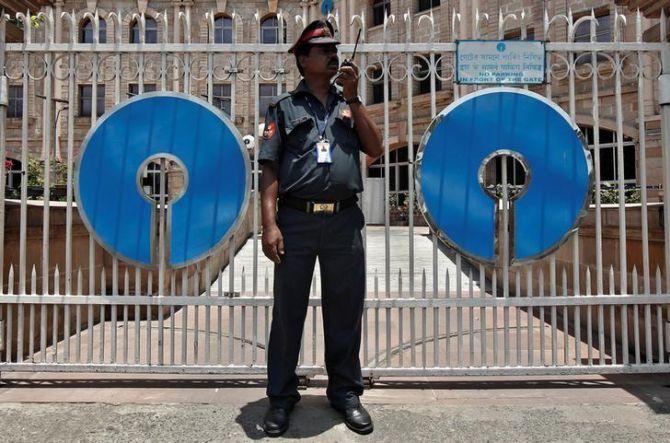Most analysts have downgraded the stock of SBI Cards and Payments (SBI Card) as the credit card issuer posted weak results during the December quarter (Q3) of financial year 2023-24 (FY24).

The sub-par show, analysts said, was for the eighth straight quarter.
With this, they have slashed their earnings estimates by as much as 20 per cent over FY24-26 amid near-term pressure points in the company's growth outlook.
"SBI Cards, yet again, reported a miss on earnings (of 10 per cent), with net profit at Rs 549 crore, and return on asset (RoA) at 4.1 per cent, due to continued deterioration in asset quality leading to higher loan-loss provisions (LLPs)/charge-off.
"Factoring-in the slower growth/higher LLP, we cut our earnings estimates by up to 20 per cent till FY26," said analysts at Emkay Global.
The brokerage has downgraded the stock to 'Reduce' from 'Buy' and has slashed its target price to Rs 725 from Rs 865.
On the bourses, shares of the credit card arm of State Bank of India (SBI) tanked 6.5 per cent to Rs 710.5 per share on the BSE in Monday's intraday trade before settling at Rs 715.6 (down 5.8 per cent).
By comparison, the benchmark S&P BSE Sensex soared 1.7 per cent to 71,942 levels.
Asset quality bites in Q3FY24
During the recently concluded quarter, SBI Card posted a 9 per cent Q-o-Q decline in PAT as provisions for impairments surged 66 per cent to Rs 883 crore.
Margins were flat sequentially at 11.3 per cent as the cost of funds (CoF) rose 50bp Q-o-Q to 7.6 per cent, while the mix of revolver (a customer who doesn't pay the full balance due each month) declined marginally to 23 per cent.
The management has guided that CoF would remain higher till Q1FY25.
Gross non-performing assets (GNPA) rose to 2.64 per cent during the quarter under review as against 2.22 per cent in Q3FY23 and 2.43 per cent in Q2FY24.
Net NPA, too, increased to 0.96 per cent from 0.80 per cent Y-o-Y/0.91 per cent Q-o-Q.
The management believes asset quality stress is likely to be more widespread, and may swiftly intensify due to higher customer leverage.
Analysts, thus, warn that delinquencies could continue to rise as stress in the multi-card and lower-bucket customer portfolio may come to the fore.
Operationally, new card addition count moderated to 1.1 million in Q3FY24 as against 1.6 million last year, partly due to devaluation of the cash-back card and the company's cautious approach amid rising delinquencies.
With this, SBI Cards clocked 18.3 per cent market share in terms of card spends, and 18.9 per cent market share in terms of cards-in-force at the end of Q3FY24.
Besides, the management added that the full impact of the Reserve Bank of India's (RBI s) increase in risk weights, which pushed cost of borrowings up by 30bp Q-o-Q, will be reflected in Q4FY24.
"Cost to income (CI) ratio rose sharply to 59.9 per cent, up 284bp Q-o-Q.
"With credit cost likely to remain high and a likely increase in CoF, the outlook remains weak," said analysts at Nuvama Institutional Equities, who have retained 'Reduce' but have cut target to Rs 700 (from Rs 760).
Slowdown bottoming out?
That said, while analysts at Kotak Institutional Equities consider higher provisions, weak NIMs, lack of improvement in revolvers, high credit cost, and declining RoE (below 20 per cent) as key near-term headwinds, they believe FY25 can show some recovery trends.
"NIM is likely to bottom out in the next few quarters, and we are probably closer to the peak of higher credit costs.
"We remain optimistic about the medium-term prospects of this business.
"We are closer to the peak levels of interest rates and credit costs and confirmation of these variables can help in re-rating eventually," they said while retaining 'Buy' rating.
Disclaimer: This article is meant for information purposes only. This article and information do not constitute a distribution, an endorsement, an investment advice, an offer to buy or sell or the solicitation of an offer to buy or sell any securities/schemes or any other financial products/investment products mentioned in this article to influence the opinion or behaviour of the investors/recipients.
Any use of the information/any investment and investment related decisions of the investors/recipients are at their sole discretion and risk. Any advice herein is made on a general basis and does not take into account the specific investment objectives of the specific person or group of persons. Opinions expressed herein are subject to change without notice.












 © 2025
© 2025